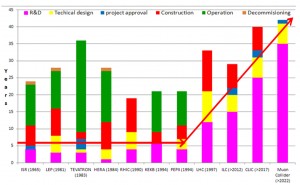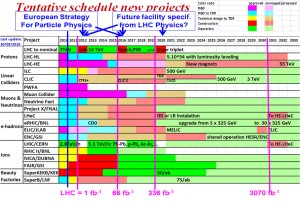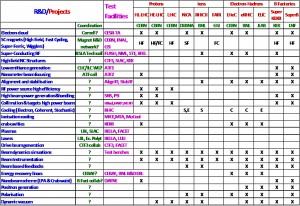As a newcomer to the Global Design Effort Executive Committee nearly two years ago, I was invited to write for ILC NewsLine’s Director’s corner, which I dedicated to one of my favorite subject: “The Beauty of Collaborations”. I would like to take this new opportunity to address a complementary subject with a plea for a strong, long-term and globally coordinated accelerator R&D programme.
Indeed, I have been more than ever convinced of the absolute necessity of a strong R&D programme after I reviewed new accelerator projects in a talk at the International Conference on High Energy Physics (ICHEP2010) held in Paris in July 2010. Barry Barish wonderfully summarised the conference in the ILC NewsLine Director’s corner of 19 August 2010.
On the occasion of this review and looking back to the past in order to better anticipate the future, I was shocked to realise the dramatic increase of time needed for the preparation of a new high-energy physics facility. The time duration between first ideas and final proposal for a new facility, including R&D, conceptual and technical designs – which remained about constant at the level of a few years, typically five – in the past, is now continuously increasing towards the scale of several decades – two to three – as outlined in Figure 1.

Figure 1. Evolution of the necessary time for accomplishing the various phases of past and present high-energy physics accelerator projects.
Such a long lead time, although alarming, is understandable since future facilities are more and more demanding. In order to get into new energy territories – called the “terascale” – and push further the frontiers of energy, intensity and brilliance, beam collisions with several megawatts of power focused to extremely small dimensions in the micrometre or nanometre range are mandatory to generate the extremely high luminosities (from 1034 to 1036 cm-2×s-1) requested. In order to maximise the performance of these facilities while maintaining their cost and power consumption within reasonable limits, novel schemes and technologies have to be developed with performances well above the present state of the art. That requires imagination, inventiveness, resources… and time.
As a consequence, the necessary R&D has to be launched a long time (up to 30 years!) in advance in order to allow proposals to be available when needed. Moreover, since the future is hard to predict, all possible requirements for the future have to be anticipated early enough and the R&D launched for ALL of them. Such a long lead time also implies sociological consequences by forcing several generations of experts to push the project forward from the beginning to the end.
During the review, I also presented a tentative schedule of all foreseen high-energy projects over the next twenty years, updated after consultation with the corresponding project leaders. Putting together the schedule of the various phases of each project known at the time on a single table with one line per project (Figure 2) allows a comparative overview and triggers a few reflections:
- The large number of projects reflects the vitality of the field.
- Only a few projects have already been approved, whereas a large majority is in an R&D, conceptual or technical design phase. Obviously, all of them will not be approved. But they all have to be studied in order to provide a large range of options from which the physics community will choose the one best suited to physics.
- Some projects are clearly in competition, which is certainly very sane, by providing challenging comparisons and motivations to make the most of the opportunity with the resources available. But it also implies some duplication of efforts.
- The relative schedule of the various projects reflects the optimism or the realism of the persons in charge and is not always consistent and/or coherent.
Borrowing from Martin Luther King, Jr., I have a dream that a global coordination of the various projects could define a coherent programme on a global and worldwide scale such that all options are correctly covered in a complementary and coherent way, thus avoiding unnecessary duplication and making the best use of the available expertise and limited resources. This dream will possibly come true since the International Committee for Future Accelerators, as an independent body, recently initiated a critical review of these projects, which will be extremely beneficial to the field.
Each of these projects is very ambitious and requires a large amount of R&D in order to develop the most appropriate technology, optimisation and industrialisation to reach the best balance among performance, risk and cost. Each project is usually coordinated by one single laboratory or by a collaboration of laboratories with a leading laboratory or by a global collaboration like the ILC Global Design Effort, the CLIC Collaboration for linear colliders or the Muon Accelerator Program for the US teams on muon colliders. Each project is therefore focused on its own development through the various phases from R&D to technical development to industrialisation, fabrication, installation and commissioning.
But the review also pointed out a large synergy of R&D subjects among the various projects as summarised in Figure 3, which outlines the issues related to each project.
In order to make the best use of resources and achieve the best possible performance in the global interest of the high-energy physics community, a global coordination of the R&D on a specific subject addressing all relevant projects could be extremely useful and more efficient than focused on an individual project as usually done at present.
I have a dream that teams made up of worldwide experts in the field would work together in close collaboration on specific subjects of R&D for the best benefit of all projects. Such a team dedicated to one of the R&D subjects applied to all projects could be coordinated by a national laboratory (usually too small to coordinate a global project). The laboratory would then be entitled with a global role well appreciated by the community and based on a local leading expertise on the subject in close collaboration with the corresponding worldwide experts.
As a conclusion, future high-energy projects (beyond the Large Hadron Collider) will be global, based on innovative ideas and technology breakthroughs which require extensive R&D developed by globally coordinated collaborations, or will not be! A strong, long-term and performing accelerator R&D is vital for the future of high-energy and is a high responsibility of the community. It is the critical key to future proposals of the best possible projects well adapted to physics needs with an optimised ratio of performances to needed resources (to build and operate) and a minimum of risks.
I have a dream that all accelerator experts would work together to develop the future in a close collaborative competition (or competitive collaboration) approach where people would closely collaborate to develop together competing technologies and/or projects. The CLIC-ILC collaboration is a shining example of such a fruitful, efficient and open-minded approach in the best interest of linear colliders and high-energy physics.




Recent Comments